Catalonia is the triangular, Maryland-sized “autonomous community” that defines mainland Spain’s northeast corner. Its capital, Barcelona, attracts visitors from around the globe. Girona, Figueres, Lérida and other Catalonia urbs get less international attention.
Catalans speak Spanish, even if some wish they didn’t, and a language of their own: Catalan, the mother tongue of roughly a third of the Catalonia population. Many there also think they should have their own country.
In 2017, Catalan separatists tried a quick end-around of the constitution by convening a referendum on nationhood. An illegal referendum, responded Spain, and chucked organizers in the slammer. A month ago, left-center Spain prime minister Pedro Sánchez tried to bury the hatchet by issuing pardons. They don’t deserve to be pardoned, cried tens of thousands, and convened on Madrid’s Colón plaza to protest.
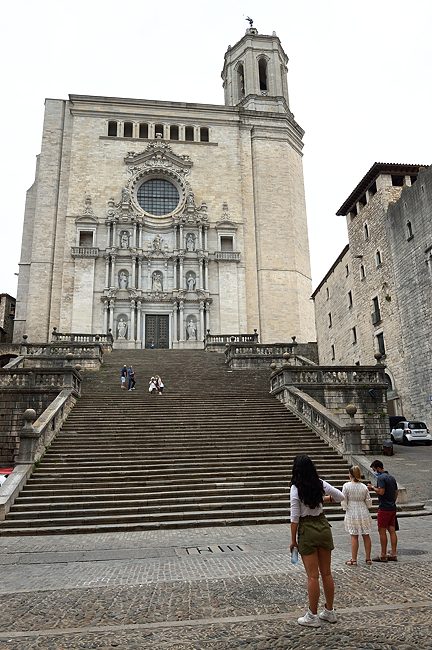
You may infer that Madrileños might regard Catalonia as an iffy tourist destination. My impression, after casually querying a few conocidos: no and yes. Some wouldn’t hesitate to visit; one said that a friend’s mom regularly enjoys stays with her daughter in Girona, although mom speaks no Catalan. In the eyes of another, separatism has tainted the whole community; he’d never go. A third hasn’t forgotten Catalan waiters who refused to answer questions in Spanish a decade ago. (They all know Spanish, but wouldn’t use it with me!)
Catalans harbor no ill will toward Yankee tourists, and I’d need strong hypnotics to convince natives that anyone with my accent grew up in Spain. And I wanted to explore.
Inefficiently and expensively, I booked two separate trips: an all-transit foray to Girona, and, a month later, a combination transit/rent-a-car trip to Costa Brava, Figueres and Catalan towns in the Pyrenees foothills. The Catalonia-is-Spain vs. Catalonia-is-a-nation spirit differed much more sharply between places than I had expected, sometimes to a bewildering extent. I took notes.
(Caveat emptor: I can accurately report what I saw, heard and sensed during my brief visits to these places, but can offer nothing resembling a real poll. Pew Research hasn’t offered me a gig in Spain, and certainly wouldn’t after reading this.)
GIRONA
Girona is a city of 100,000 eighty-five kilometers north of Barcelona. Separatist leader Carles Puigdemont was the city’s mayor.
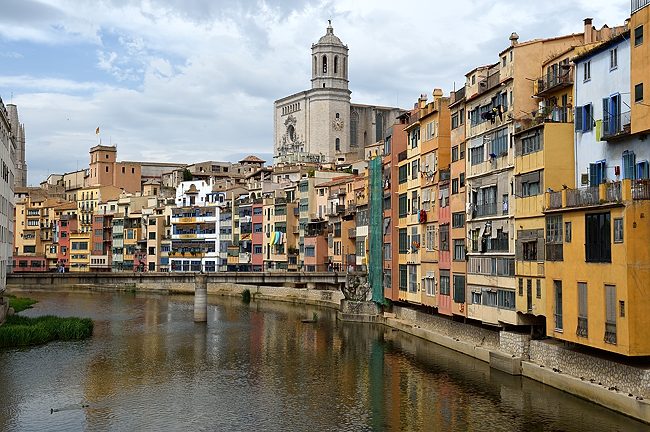
Girona is known as a separatist stronghold, and sized up as one during my trip. Most every upward glance at windows and balconies showed Estelada independence flags, pro-independence banners and — before the pardons — countless yellow ribbons, showing allegiance with the imprisoned separatist leaders.
(Pundits, P.R. types and other massagers-of-public-opinion may snicker at the contrast between this yellow ribbon explainer in the Catalan press and an article in Madrid’s El País.)
But, I did not hear only Catalan in Girona. I’ll guesstimate that fully forty percent of overheard chat was in Spanish. With one exception, locals responded in unselfconscious Spanish to my Spanish questions.
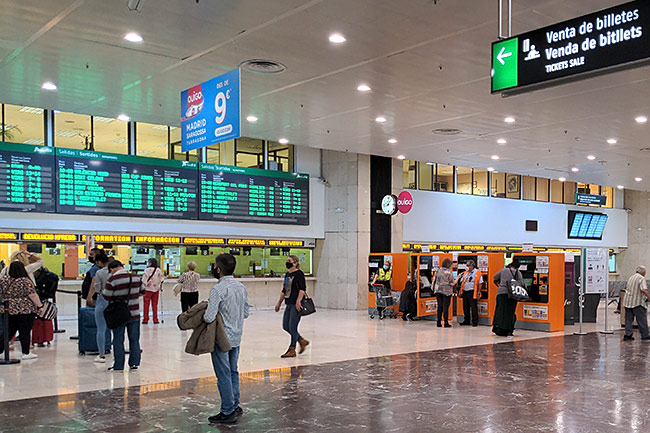
Catalonia’s Rodalies commuter rail network makes Girona an especially attractive trip add-on for the Barcelona-based tourist. Service is only once-an-hour off-peak, but tourists can admire the Catalan countryside during the ninety minute ride, and can board directly from the Barcelona-Sants rail station.
The photo above shows where I bought my Rodalies ticket at Barcelona-Sants after exiting my AVE ride from Madrid. See the gentleman in the orange vest? Someone like him probably will be on hand to explain how to coax a ticket from the orange machines and where to go to board the R11 to Girona. I bought a round-trip ticket for a mere 22.50€, and needed only twenty minutes to stroll from the station to my heart-of-Girona hotel.
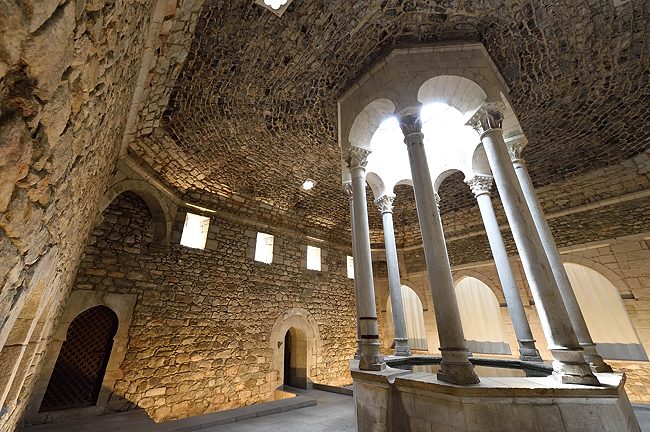
Girona is lovely, green, walkable and offers plenty to see. (Although I couldn’t stroll the muralla, a victim of pandemic closures.) The pedestrian Rambla offers terrace restaurants galore. Recommended, especially for the car-free tourist contemplating free days in a Barcelona travel itinerary.
COSTA BRAVA
“Costa Brava” = the roughly two hundred kilometers of Spanish Mediterranean coastline from Barcelona’s north to the French border. Not a transit paradise, a travel blogger warned; I’d explore more easily behind the steering wheel. I again rode a speedy AVE from Madrid to Barcelona-Sants to begin this second Catalonia trip, but skipped the Rodalies transfer, and instead ascended to the rent-a-car lot on the station roof.
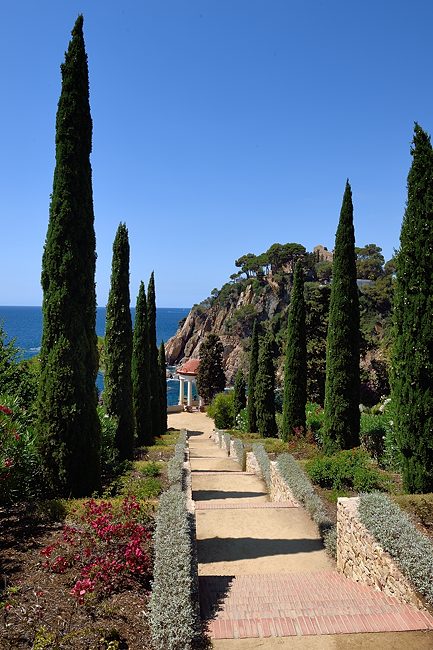
(On the roof, literally. Exit the Sants station toward Plaza de los Países Catalanes, look for the white stairs. You’ll see the stairs and the rooftop lot if you dink around in Street View.)
The shot above was taken at the Marimurtra Botanic Garden in Blanes; the shot below, at the Gardens of Saint Clotilde in Lloret de Mar, a few kilometers north. My travels have introduced some spectacular gardens around the world, from the Botanic Garden in Munich to the Royal Botanic in Melbourne, to the I-dripped-sweat-every-second-I-was-outdoors National Garden in humid Singapore. (And the spirit of Andalucia’s Felipe de Neve himself may smite me if I fail to mention the Huntington and Arboretum in Los Angeles, or the Botanical Garden (with redwood grove!) in San Francisco.)
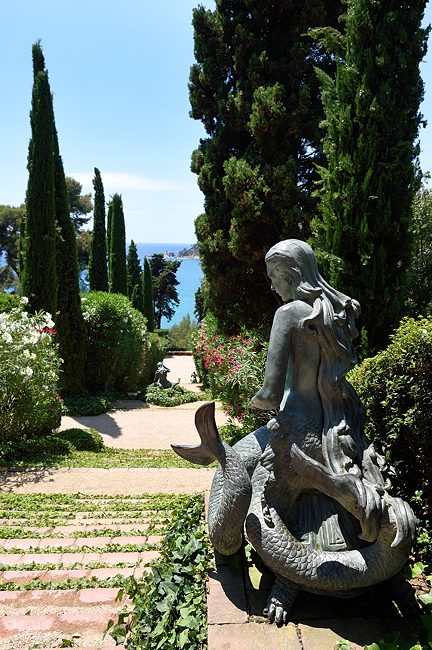
With these acknowledgements offered, it’s time to dust off the first tier superlatives: Marimurtra and Saint Clotilde qualify as the single most spectacular gardens I’ve seen in the life lived to date. Plant tenders at other sites may be better funded, more careful, even more expert, for all a black-thumbed floricultural know-nothing like me could say; you just can’t beat those views of the gleaming blue Mediterranean, shimmering under the sun mere meters away. Location, location, location.
(Travel tip: if motoring to Marimurtra, consider berthing the jalopy among the many paid, blue-slotted spaces near Ermita Santa Barbara, a quarter mile from the garden entrance. Hunt for the curbside meter, slip in a coin, fetch the ticket, leave the ticket on the dash. Easy. You’ll have time to admire the bucks-up hillside homes en route to the garden, which look to be in the Sausalito or Pacific Palisades tax bracket.)
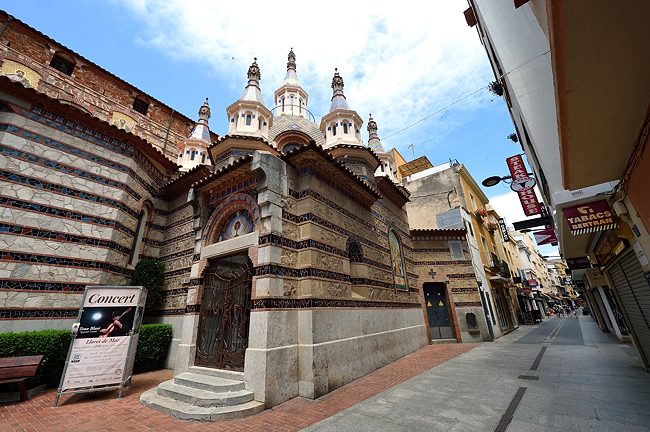
Central Lloret de Mar hugs the shore east of Jardins de Santa Clotilde, and felt much more like a sleepy California beach town than anything I’d expect on this side of the Atlantic. I picked a pleasantly crooked path through a labyrinth of narrow streets, past pubs, tattoo parlors, pizzerias, ice cream stands, even a fortune teller, reached the Iglesia de Sant Roma I had hoped to visit, and found it closed. That’s what I get for traveling with an old guy.
Blanes and Lloret de Mar sized up as iffy candidates for a separatist vote. All overheard chat was in Spanish, with one Catalan exception apiece in either town. Garden and restaurant staff began chats in Spanish. I saw one Estelada near Sant Roma in Lloret de Mar, but also spotted a biker sporting a small Spanish flag, and a pedestrian in a jacket striped proudly in Spain’s red and yellow. Not at all what I’d expected, given impressions formed earlier in Girona.
I found more of a mixed bag in Figueres, visited briefly in late afternoon: several Esteladas, and what looked like a political party poster for Carles Puigdemont near Figueres’ short Rambla.
CATALAN PYRENEES
I spent the night in Besalú, continued the next day to Olot, then Ripoll, then Puigcerdà before girding loins for the long drive south to the flatlands, where I would drop off the rental in big city Lérida and catch my return AVE to Madrid.
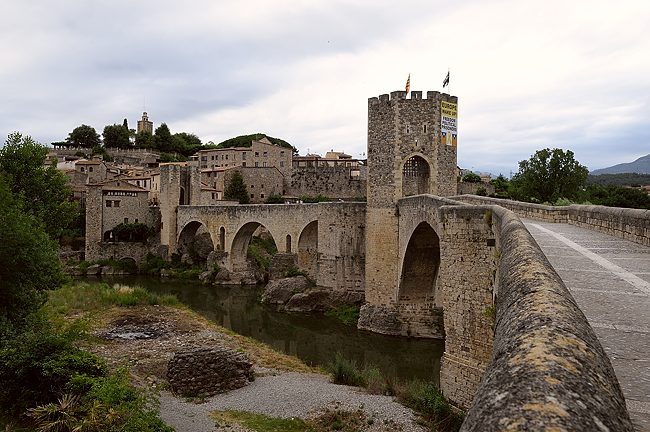
Please note Wikipedia’s population stats for these alpine hamlets: respectively, 2,467 in Besalú; 34,486 in Olot; 10,632 in Ripoll and 8,981 in Puigcerdà. Comely as all get-out, unquestionably, but bristling with urban amenities, no. (Although Olot feels more citified.) The motorist should expect to patiently see-saw the steering wheel while traveling up, down and between wooded foothills, on two and even one lane roads, around and through the town centers of other Catalan whistlestops, while surrounded by Pyrenees postcard scenery along the way. A motoring association could shoot promotional photos here.
(What if you want to visit without a car? Rodalies shows a train between Ripoll and Puigcerdà, but with infrequent service, and other options are scarce. You’re in the mountains, after all.)
Besalú, Olot and Ripoll support Catalan independence. Trust me. I didn’t have to ask. Yellow ribbons and Esteladas everywhere, including the giant English banner shown above on the Besalú bridge, and independence-related graffiti between towns. Later, I would see yellow ribbons painted on freeway lanes north of Lérida, and pro-independence banners draped from overpasses.
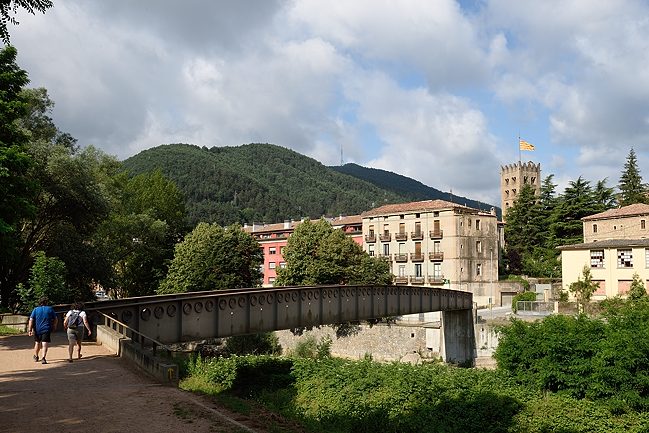
I don’t entirely trust my memory for what follows, but believe now that in these three towns only my gentlemanly Besalú hotelier spoke to me at length in Spanish, and this was because his A1 English obviously wasn’t going to cut it for essential hotel-to-guest communication. I was a paying customer, simply had to be informed where to leave the key for an early departure, unless he wanted to pay a locksmith after I left.
Other chats were in English, or a one-side Catalan. I parked at a garage by a market in Olot, asked in Spanish about market opening times. A cashier answered in Catalan. I looked bewildered, repeated the question. He answered again, also in Catalan. This may sound rude, but didn’t feel rude when it happened. Everyone was polite, but locals clearly preferred to use their rusty English instead of their fluent Spanish … or, in this one isolated example, to use Catalan, period.
On to a seventy minute drive to Puigcerdà, deeper still in the Catalan Pyrenees hinterlands. Maybe they’ll be so gung-ho on independence that they won’t let me out of the car without completing a loyalty test, thought I.
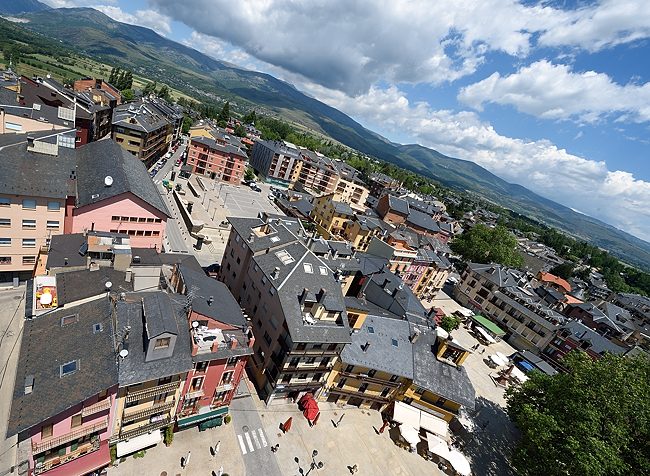
No, not at all. Just the opposite. No Estaladas, no pro-independence anything. I was a twenty minute stroll south of the French border, so wasn’t surprised to overhear two chats in Français. All other overheard chat was in Spanish, and I communicated as unselfconsciously in Spanish as I do on Gran Vía.
Go figure. And this night-and-day difference was only sixty kilometers northwest of Ripoll. I don’t get it.
I didn’t do much in Lérida except drop off the rental and while away hours over a meal on Plaça de Sant Joan while awaiting my return AVE ride to Madrid. Still, the in-town vibe struck me as solidly Spanish, despite a strong pro-Independence province tilt in the 2021 election. (Please note that the city is regularly referred to as Lleida in Catalan, and Lérida in Spanish. Same place, two widely-used names.)
ABOUT CATALAN INDEPENDENCE
Age can teach caution, often unpleasantly. She who chants for a cause and later decides that she should have chanted for her opponents may hesitate to hoist the megaphone the next time around. I write confidently about what I saw and heard on the road, much less confidently about Catalan independence.
Still:
I’m sure that I want a strong, healthy European Union. I see the EU as more pacific and humanitarian than the U.S., Russia or China. The world needs it. A robust EU might even make a fractional difference in the positive evolution of our species.
I doubt I’ll get my strong, healthy EU if the union permits itself to dissolve in fractious separatist movements. Online maps — here, here — are badly flawed, as they don’t distinguish between movements that are active and dormant. But Catalonia isn’t alone, and that fact may explain the EU’s willingness to stand aside in 2017, to regard the attempted referendum as an internal Spain matter.
Further, five years of Brexit turmoil show that a Catalan divorce from Spain would be a decade-long bureaucratic nightmare, a holocaust of regulation and red tape. Almost 1,700 businesses moved their headquarters out of Catalonia after a referendum that wasn’t even authorized. Anyone sober enough to pilot a working enterprise could see what kind of ca-ca would hit the fan if the referendum had grown teeth. Thousands and thousands of new edicts, laws, regulations, procedures for business, courts, hospitals, schools; exhaustive divorce negotiations with likely hostile (or at least thoroughly irritated) Spanish and EU functionaries over transfer of licenses, pension benefits; the whole unnecessary, Everest-sized bureaucratic dogpile foisted both on the pro-independence Catalans who might vote for the nightmare and the shocked, furious, disbelieving Catalan millions who never wanted to leave Spain in the first place. Think of all the fun businesses and health center staff have had to comply with genuinely necessary Covid regs. Multiply by a thousand. Ten thousand.
My impression as an inadequately-informed outsider is that Catalan independence only moved to the front burner after a 2010 court ruling on an autonomy statute. For the sake of the EU, I hope more Catalans can be persuaded to again think comfortably of their community as part of Spain.
To see full-sized copies of the shots above and other Catalonia trip photos, please visit the photo directory: https://transitophile.com/chango/files/catalonia/
and/or the Catalonia photo album on Flickr: https://www.flickr.com/photos/36217981@N02/albums/72157719602206190
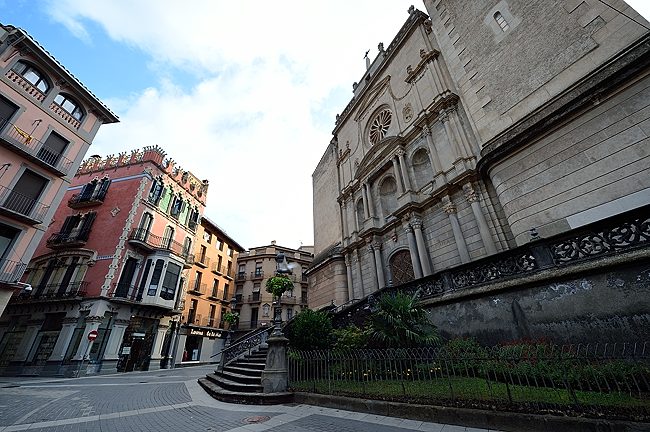
Going as per the uploaded photographs, Catalonia looks a picture-postcard destination. I can say that this post can force many to include Catalonia in their bucket list as it has done to me
Hi Tim,
Your trip through the Pyrenees was much more interesting than the several times I went to Barcelona with my first husband, Edward. He wasn’t much of a traveler, wanted to hole up in Barcelona and stay there. I must say that I loved Barcelona more than any of the other cities in Spain. Bilbao, in the Basque Country, is a close second. Madrid? Too big, too fast.
I am enjoying, with great envy, your travel tales.
Thank you, mare!